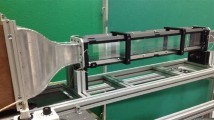Abstract
The multi-plane stereo particle image velocimetry (MSPIV) technique has been applied to an investigation of the spatial and temporal development of turbulent spots in a laminar flat-plate boundary-layer flow with a slight adverse pressure gradient. On the basis of a large number of evaluated instantaneous 3- and 2-component velocity-vector fields, measured synchronously and separated in space, or with different time separations in one or two planes, the technique enabled the determination of several statistical quantities of fluid mechanical significance. The shape and role of coherent substructures for the growth and turbulent mixing of the spot were the focus of this investigation.













Similar content being viewed by others
Abbreviations
- x, y, z :
-
stream-, normal-, and spanwise coordinate
- U ∞ :
-
freestream velocity (U ∞=7 m/s)
- Re :
-
Reynolds number, =Re x 1/2
- u, v, w :
-
instantaneous velocity components
- u′, v′, w′:
-
fluctuation velocity components
- Q-1,...,4:
-
quadrants of Reynolds stress u ′ v'
- PDF:
-
probability density function
- R ii :
-
space–(time)-correlation function
- λ :
-
wavelength of laser light
- TE:
-
trailing edge of turbulent spot
- LE:
-
leading edge of turbulent spot
References
Adrian RJ, Meinhart CD, Tomkins CD (2000) Vortex organization in the outer region of the turbulent boundary layer. J Fluid Mech 422:1–54
Cantwell B, Coles D, Dimotakis P (1977) Structure and entrainment in the plane of symmetry of a turbulent spot. J Fluid Mech 87:641–672
Coles D, Savas O (1980) Interaction of regular patterns of turbulent spots in a laminar boundary layer. In: Eppler R, Fasel H (eds) Laminar–Turbulent Transition, IUTAM Symposium, Stuttgart, Germany, 1979. Springer-Verlag, Berlin Heidelberg New York, pp 277–288
Emmons HW (1951) The laminar–turbulent transition in a boundary layer, I. J Aeronaut Sci 18:490–498
Gad-el-Hak M, BlackwelderRF, Riley JJ (1981) On the growth of turbulent regions in laminar boundary-layers. J Fluid Mech 110:73–95
Kähler CJ, Kompenhans J (1999) Multiple plane stereo PIV—technical realization and fluid-mechanical significance. In: Proceedings of the Third International Workshop on PIV, 16–18 September 1999, University of Santa Barbara, USA
Kähler CJ (2000) Multiplane stereo PIV—recording and evaluation methods. In: Proceedings EUROMECH 411, 29–31 May 2000, Rouen, France
Matsui T (1980) Visualization of turbulent spots in the boundary layer along a flat plate in a water flow. In: Eppler R, Fasel H (eds) Laminar–Turbulent Transition, IUTAM Symposium, Stuttgart, Germany, 1979. Springer-Verlag, Berlin Heidelberg New York, pp 289–296
Meinhart CD (1994) Investigation of turbulent boundary-layer structure using particle-image velocimetry. Thesis, University of Illinois at Urbana-Champaign
Robinson SK (1991) The kinematics of turbulent boundary-layer structure. NASA Technical Memorandum 103859
Rotta JC (1972) Turbulente Strömungen, Eine Einführung in die Theorie und ihre Anwendung. B.G. Teubner Verlag, Stuttgart
Sankaran R, Sokolov M, Antonia RA (1987) Substructures in a turbulent spot. J Fluid Mech 197:389–414
Schoppa W, Hussain F (1997) Genesis and dynamics of coherent structures in near-wall turbulence. In: Panton R (ed) Self-sustaining mechanisms of wall turbulence. WIT Press, Southampton, 385–422
Schröder A (2001) Untersuchung der Strukturen von künstlich angeregten transitionellen Plattengrenzschichtströmungen mit Hilfe der Stereo und Multiplane Particle Image Velocimetry, http://webdoc.sub.gwdg.de/diss/2001/schroeder/schroeder.pdf
Singer BA (1996) Characteristics of a young turbulent spot. Phys Fluids 8:509–521
Tufo HM, Fischer PF, Papka ME, Blom K (1999) Numerical simulation and immersive visualization of hairpin vortices. http://www-unix.mcs.anl.gov/appliedmath/Flow/cfd.html
Wygnanski I, Zilberman M, Haritonidis JH (1982) On the spreading of a turbulent spot in the absence of a pressure gradient. J Fluid Mech 123:69–90
Acknowledgements
The authors would like to thank C. Kähler and H. Eckelmann for valuable discussions.
Author information
Authors and Affiliations
Corresponding author
Rights and permissions
About this article
Cite this article
Schröder, A., Kompenhans, J. Investigation of a turbulent spot using multi-plane stereo particle image velocimetry. Exp Fluids 36, 82–90 (2004). https://doi.org/10.1007/s00348-003-0644-7
Received:
Accepted:
Published:
Issue Date:
DOI: https://doi.org/10.1007/s00348-003-0644-7




